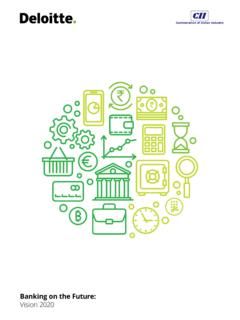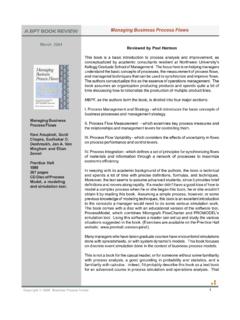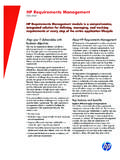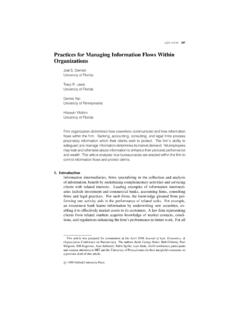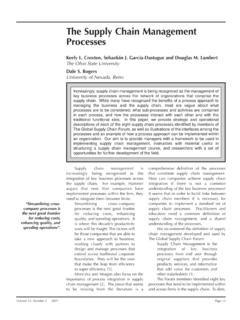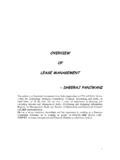Transcription of Technology business management - Deloitte US
1 Technology business ManagementRunning IT as a businessSince the 1990s, businesses have been managing their operations with Enterprise Resource Planning (ERP) systems, which have enabled centralized control over operations by implementing a common data model and integrated business processes. However, ERP systems may not extend to the realm of managing the business of IT and CIOs are now challenged to run their organizations with the same discipline as other parts of the , Technology business management (TBM) can offer the same opportunity for transformational improvements that are found in ERP. Namely, IT organizations can improve IT business processes to enable more efficient and effective use of IT resources. Increased visibility into IT expenditures and IT usage patterns on a real-time basis can also enable more informed decisions about IT investments. And lastly, automating the process of managing IT activities combines with detailed reporting to help create a closed loop solution wherein continuous improvement can be the improved information, streamlined processes and better decision making that can be enabled by TBD, CIOs may be in an improved position to communicate the value that IT value of TBM echoes that of ERP s value to the businessEnterprise Resource ManagementProcess Efficiency & Effectiveness Optimizing the use of scarce resources ( , money, people and assets).
2 Balancing resource supply and demand. Prioritizing work effort based on transparency of resource capacity across the enterprise (added capacity without additional investment). A common data model and application integration eliminate duplicate data entry or the need to synchronize changes between multiple applications. With an integrated set of process flows , both the enablement and the adoption of leading practices becomes much easier. Data governance optimizes process consistency, process efficiency, and Time VisibilityClosed Loop System Providing a comprehensive enterprise view with real-time information available to management anywhere at any time. Fully informed decisions. A single source of the truth from transactional data that is captured at the source. Closing the loop is a term that was coined in the days of MRPII, the predecessor to ERP. Information feedback enables plans to be checked and adjusted based on real-time transactions.
3 Integrated applications mimic actual business process flows in the whole is greater than the sum of the partsTBM encompasses a broad set of processes and application areas that when properly integrated can create a whole that is greater than the sum of its parts. TBM is both strategic and tactical, including a number of different applications that address functionality ranging from financial management to application lifecycle management . In many organizations, these distinct process areas are not only treated as silos, but also vary widely in their level of adoption and their maturity. ApplicationTechnology business management (TBM)DemandManagementIT Financial management (ITFM)Project/Program ManagementIT Service management (ITSM)Request ManagementResource ManagementPlanningQualityIdeationQualifi cationAnalysisRelease PlanningPrioritizationProjectInitiationR equestProjectServiceInitiationServiceSer viceClosureService ExecutionProjectClosureProject ExecutionTimeCostControlTestingRequireme ntsResourcesCommunicationRiskService StrategyService DesignService TransitionService OperationMonitoringFinancial PerformanceMeasurementForecasting/Budget ingAccounting/ControllingRe-alignmentPor tfolio management /GovernanceRelease ManagementApplication Portfolio StrategyArchitectureApplication Portfolio ManagementStandardsApplication Portfolio management (APM)The business of Technology business ManagementTechnology business ManagementProject Portfolio management (PPM)IT Financial management (ITFM)
4 IT Service management (ITSM)Application Portfolio management (APM)TBM is an integrated set of processes across multiple application areasTBM enables a closed loop process for continuous improvementAn integrated frameworkCurrently, no one application facilitates all of TBM s capabilities. Therefore, integration of supporting products should be required to achieve the full solution. An integrated solution should include many process areas. Decision makers throughout the business should use its results. TBM s processes support information management and performance improvement to business analytics. When this framework is fully integrated, it can close the loop on IT strategy, people, process , and roadmap to maturityIt s important to recognize that people, process , and Technology improvements can be achieved in small change increments. It may not be necessary or recommended to start with a big bang implementation of TBM because value can be achieved one area at a time.
5 However, it is important to have a vision and a design that is used as a roadmap for delivering business value from improved IT management . This can enable the implementation in any single area to be aligned with a long-term plan. Deloitte has defined a methodology for TBM strategy and implementation to go from the current state to a desired stage of maturity. The methodology is used to guide the project through three phases: Assess TBM maturity Create solution roadmaps Develop an implementation planThe TBM roadmap provides a detailed implementation planCurrent vs. future state maturity1 = Initial/Ad-Hoc 2 = Defined 3 = Managed 4 = Measured 5 = OptimizedDemandManagementRMITSMPPMF inanceManagement12345 InitialGoal0 APMC ategoryCurrentFutureFinance .1 Demand process starts with the TBM maturity assessment, which leads to the TBM roadmap, which provides the detailed implementation plan for incrementally and sequentially improving maturity of TBM capabilities.
6 The maturity assessment phase includes assessing the current maturity for each area of BPM and then defining a desired future state. Comparing the scores for current versus desired future state maturity illustrates the most urgent maturity needs and where the most value can be roadmap is then created from the results of the maturity assessment and future state strategy. The roadmap defines detailed initiatives that will advance TBM maturity to the desired state. The implementation plan defines how the roadmap can be carried out. It defines the timing of each step, starting with those areas that will provide the greater value against the implementation plan is what moves the organization to the desired maturity described in the vision and strategy document. The execution includes an iterative process wherein continual assessments along the way serve to assess and better execute the implementation steps. The project is tracked in terms of progress in closing the gaps between the current state and desired future state.
7 It may improve maturity in some TBM categories before others. This publication contains general information only and Deloitte is not, by means of this publication, rendering accounting, business , financial, investment, legal, tax, or other professional advice or services. This publication is not a substitute for such professional advice or services, nor should it be used as a basis for any decision or action that may affect your business . Before making any decision or taking any action that may affect your business , you should consult a qualified professional advisor. Deloitte shall not be responsible for any loss sustained by any person who relies on this used in this document, Deloitte means Deloitte Consulting LLP, a subsidiary of Deloitte LLP. Please see for a detailed description of the legal structure of Deloitte LLP and its subsidiaries. Certain services may not be available to attest clients under the rules and regulations of public 2015 Deloitte Development LLC.
8 All rights reserved. Member of Deloitte Touche Tohmatsu LimitedContactsTo learn more about how Deloitte can help provide increased business value from IT investments, please contact one of the team members listed below:Chris Garibaldi Principal, PPM Practice Lead Deloitte Consulting LLP +1 816 797 7135 Rob Garvey Sales Executive Director Deloitte Services LP +1 313 574 0598 Michael Ravin Specialist Leader Deloitte Consulting LLP +1 703 251 3689 Change is imperativeCompanies have been talking about managing IT as a business for quite some time. The ERP boom of the last 20 years was ignited by some compelling events such as Y2K and compliance requirements, including the Sarbanes-Oxley Act of 2002. Yet ERP implementations have not addressed the need to manage IT as a business and most IT organizations are still a long way from achieving such a vision. There is a new normal emerging in business as the result of an unprecedented convergence of revolutionary IT forces.
9 The fragmented IT management processes and systems of the 1980 s and 1990 s may not allow IT organizations to effectively meet the rapidly changing demands. To cross that chasm, IT organizations should take a holistic view of IT, integrating the most important business processes in order to help reduce effort, lower costs, and provide better information to IT management at all is a foundational part of the solution that can enable IT organizations to transform their management disciplines and keep up with the modern pace of change.









